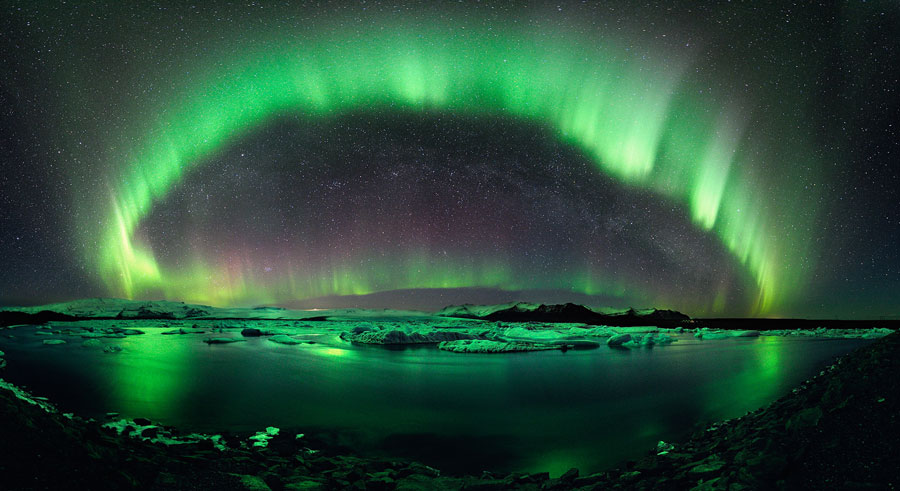Science Friday: Earth, Sky, and Space
1st, a study shows how the atmosphere above Japan heated rapidly before the M9 earthquake. Then, the galaxy may swarm with billions of wandering planets. Then, researchers find that quiet places on Earth’s Crust are core-meltingly hot underneath. Then make sure to scroll all the way down for an award winning picture of the Aurora Borealis over a glacial lake in Iceland. The song is "Beneath a Phrygian Sky" by Loreena McKennitt
Atmosphere Above Japan Heated Rapidly Before M9 Earthquake

- Geologists have long puzzled over anecdotal reports of strange atmospheric phenomena in the days before big earthquakes. But good data to back up these stories has been hard to come by.
In recent years, however, various teams have set up atmospheric monitoring stations in earthquake zones and a number of satellites are capable of sending back data about the state of the upper atmosphere and the ionosphere during an earthquake.
Last year, we looked at some fascinating data from the DEMETER spacecraft showing a significant increase in ultra-low frequency radio signals before the magnitude 7 Haiti earthquake in January 2010
Today, Dimitar Ouzounov at the NASA Goddard Space Flight Centre in Maryland and a few buddies present the data from the Great Tohoku earthquake which devastated Japan on 11 March. Their results, although preliminary, are eye-opening.
They say that before the M9 earthquake, the total electron content of the ionosphere increased dramatically over the epicentre, reaching a maximum three days before the quake struck.
At the same time, satellite observations showed a big increase in infrared emissions from above the epicentre, which peaked in the hours before the quake. In other words, the atmosphere was heating up.
[...]
http://www.technologyreview.com/blog/arxiv/26773/
The galaxy may swarm with billions of wandering planets
- A new result from astronomers who have spent years peering toward the center of the Milky Way has led to a startling conclusion: there may be billions of Jupiter-sized planets wandering the space between the stars, unbound by the gravity of a parent sun. In fact, there may be nearly twice as many of these free floating planets as there are stars themselves in our galaxy, and they may even outnumber planets orbiting stars!
The study, published in Nature, is the result of the Microlensing Observations in Astrophysics (MOA) project. Instead of looking for tell-tale blips of light near stars, or the effect of planets on their parent stars, microlensing looks for the effect of the planet on background stars that are far more distant than the planet itself.
It’s a little weird, and is due to gravity warping space. Imagine me sitting on a flat floor, rolling marbles away from me in all directions. If you’re sitting a few meters away, you can only catch the marbles that are aimed at you. But if there’s a dip in the floor between us, some of the marbles I roll that might have otherwise passed you will get their path diverted toward you as they curve around the dip. You get more marbles!*
Related: Stanford proves Einstein right again, with Gravity Probe B
- The same thing with light and gravity. A star emits light in all directions, but we only see the small amount of light headed our way. If a massive object like a planet gets between us and the star, the gravity of that planet can warp space, causing light we otherwise wouldn’t see to bend toward us. We see more light: the star gets brighter! This is called a gravitational lens. If that massive object is a planet moving in space, then we the starlight get brighter as the planet moves between us and the star, and then fainter as the planet moves on. The way the light changes is predicted by Einstein’s equations of relativity, and can be used to find the mass of the planet doing the warping.
[...]
http://blogs.discovermagazine.com/badastronomy/2011/05/18/the-galaxy-may-swarm-with-billions-of-wandering-planets/
Quiet Places on Earth’s Crust Are Core-Meltingly Hot Underneath
- What’s the News: In geologists’ traditional view of the middle of the Earth, the solid inner core is gradually growing as more of the liquid core freezes, as the planet continues its billions-of-years-long process of cooling off. But now scientists are suggesting that parts of the solid inner core get so hot that they turn liquid, and that this is all linked to what’s happening in the Earth’s crust—meaning that our the earthquakes, volcanoes, and plate tectonics that we see are connected to the very heart of the planet.
- Using computer models and seismology data, the researchers discovered that parts of the mantle can become hot enough that heat is forced back into the core, melting “a small fraction of the inner core’s surface.” They say it’s possible that around 1% of the inner core’s surface is melting, which is roughly 77,000 square miles.
- Below the Pacific Ocean’s seismically active “Ring of Fire,” for example, heat is expelled from Earth’s interior via volcanoes and cold crustal plates get thrust into the mantle, all “drawing a lot of heat from the core, helping it freeze.” But underneath regions in Africa and the Pacific that are far away from any of these heat-expelling processes, models show that the mantle can get so hot that it begins melting the inner core. It suggests “that the whole dynamics of the Earth’s core are in some way linked to plate tectonics, which isn’t at all obvious from surface observations,” says co-author Jon Mound.
How the Heck:
[...]
http://blogs.discovermagazine.com/80beats/2011/05/20/quiet-places-on-earths-crust-are-core-meltingly-hot-underneath/

The Aurora Borealis at Jökulsárlón, the largest glacial lake in Iceland via NASA's APOD
- Tjadendevries's blog
- Login or register to post comments
-



















